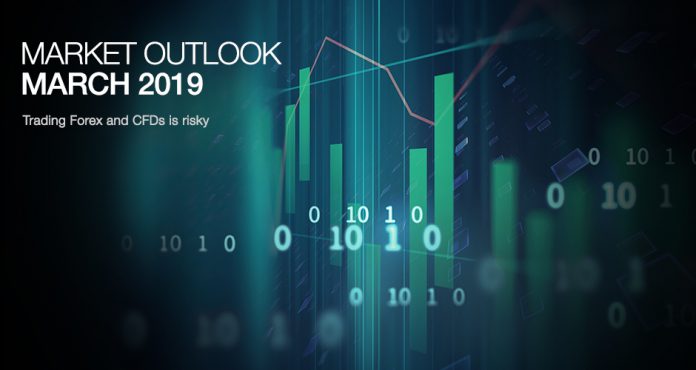February was a positive month for Sterling as markets reacted positively to the possibility of a Brexit delay. In contrast, the Dollar moved lower as data releases confirmed the view of a US slowdown. Read the below to see what March holds for traders, including a new section covering the equity pick of the month.
Click the button below for a FREE copy of our Monthly insights for February 2019 and get an overview of some of the key events for the month ahead.
CLICK HERE FOR THE .PDF VERSION OF THE OUTLOOK
CURRENCIES
Dollar: The Dollar started off the month quite strongly as the US shutdown ended, but the situation quickly reversed as data releases supported the slowdown view of the US economy. The EURUSD pair averaged lower in February than in January, reaching lows of about 1.12 during the month. The Fed is not expected to raise interest rates yet, even though GDP developments suggest that the US central bank was correct in raising them as the economy grew at a 2.6% annualized rate in Q4. While two rate hikes are expected in 2019, the Fed is likely to continue a “wait and see” stance in March as the effect from the government shutdown is still uncertain. March starts off with the Retail Sales release on the 1st and the NFP coming out on the 8th. Inflation data on March 12 come out ahead of the FOMC meeting on March 20.
Euro: Developments in the Euro continued to be less positive than expected with the ECB, after admitting to expectations of lower Euro Area economic growth, being prepared to offer TLTROs to counter them, even if these come as the result of international developments. No progress was made with regards to Brexit, even though the EU appears more prepared for a no-deal Brexit. March starts with inflation on the 1st, while the ECB meeting on March 7 should shed more light on future policy actions. Most importantly, March 29 marks the day when the UK is due to leave the European family.
Sterling: February saw a continuation of the Sterling uptrend, as markets anticipate a Brexit delay. Still, as no discussion was made with the EU officials on the topic, Brexit will again dominate the headlines, however it could be the final month this happens as March 29 is the final Brexit day. The next BoE meeting on March 21 should also weigh on political developments, while inflation and GDP, out on the 21st and the 29th respectively, are expected to show whether the UK is also experiencing a slowdown.
Yen: The Japanese currency was a loser against the Dollar in February, albeit still trading stronger than its December lows. Trade performance was worse than expected perhaps due to the global trade tensions, even though inflation remains relatively stable as retail sales declines. Household spending on March 7, the BoJ decision on the 14th, the trade balance on the 18th, and the CPI on March 22 stand out during the month.
Aussie: The Aussie traded relatively flat against the Dollar due to improved trade balance and positive employment change and despite the continued worsening of the housing sector, worse than expected retail sales, and continued negative loans growth. March starts with house sales on the 1st and a likely no change interest rate decision on the 4th, while the Trade Balance and GDP are both out on the 6th.
Loonie: The Loonie managed to maintain its gains against the Dollar, following the latter’s weakness as the price of Oil maintained a slight upwards trend. The BoC decision on March 6, labour market data on the 8th, and Retail Sales and Inflation on the 22nd are the events which are expected to have the greatest impact on the currency.
Emerging: The Ruble traded at around the 65 mark against the Dollar, with mostly sideways moves, despite the interest rate differential. In contrast, the ZAR lost ground as uncertainty regarding the country’s economic outlook continues, with the same pattern observed for the Mexican Peso. The Turkish Lira moved in tandem, losing some ground but still maintaining most of its January gains.
COMMODITIES
Gold: After gaining significantly in January following the expected world slowdown, Gold continued its upwards trend, however being unable to remain over the 1330 mark. The rise in Gold was also aided by the decrease in the 10-year bond yield and was not affected by the overall positive performance of the US market indices. As also discussed in February’s monthly outlook, the central bank shift to stable interest rates could allow Gold to retain its gains, even though the easing of tensions could potentially have a negative effect.
Silver: The price of Silver was slightly positive in February, following Gold’s path, and also appears to have gained from global market concerns and risks. However it could be up for a volatile year if global uncertainties ease.
Oil: Oil continued its upwards trend in February, ending the month around the $56 mark despite a mid-month slump after the agreed OPEC+ supply cuts. Still, prices were quite volatile as they continued to fluctuate as demand and supply are still quite unpredictable: a reduction in US oil inventories pushed prices higher, while international supply issues, stemming from the ongoing crisis in Venezuela and uncertainty over the fate of US Iranian Oil imports, are also expected to be a key theme in the coming month.
INDICES
US: The US markets (USA30, USA100, and USA500) moved positively again in February, albeit still not recovering to the late-October peak. Despite the ongoing trade tensions, markets appear to have over-priced the reduction in corporate profits, even though if the slowdown continues market growth could be lower than expected. The “wait and see” stance from the Fed aided in boosting market sentiment, as dovish comments along with delayed rate hikes should be beneficial to the economy. The unexpected increase in Q4 GDP to 2.6%, compared to expectations of 2.2%, shows that the US economy is still resilient even though this confirms the slowdown in growth, as Q3 growth stood at 3.4%.
Europe: Stock markets in continental Europe moved in tandem with the US exchanges, as the GER30 and FRA40 continued their rise, despite mixed economic data releases, while the NETH25 registered some signs of stabilization over the last days of the month. The biggest loser was the UK100, as markets reacted negatively to the appreciation of the Sterling, and perhaps also regarding the market’s concern about the state of UK business if Brexit is delayed.
Japan: The JPY225 moved inversely to the Yen and continued its uptrend, in conjunction with the overall trend in Europe and the US. The Japanese economy has underperformed over the past month, however the overall economic outlook is positive for the country as inflation continues to remain above zero and spending and loans growth remain positive. The macro environment could also benefit from a relaxation of trade tensions.
EQUITY PICK OF THE MONTH – APPLE
After being the world’s most valuable company for the first three quarters of 2018, APPLE lost its place after dropping more than 38% in the October-December period. The drop, which was nearly double that of the general market, was associated with revenue losses as a result of a general stagnation in the smartphone market, combined with a decline in margins coming from increases in material costs if the China tariffs were pushed through. Since then, APPLE’s stock price has increased by 22%, in line with the rest of the market, albeit exhibiting a more volatile nature.
March is traditionally the month when events are hosted, with new launches in almost every event. While many aficionados are speculating on the number and type of new products to be announced, the fact is that APPLE may be very keen to prove naysayers wrong and may be even expand its target market by pushing cheaper products into the market. Even in the opposite case, where the company chooses to focus on higher-end products, understanding where APPLE aims to focus could make investors happier, as it would provide more insights as to the tech giant’s future. As Trump has pushed the escalation of China tariffs until later, APPLE’s costs should remain as in Q4, and may even decline in the case that the ban is lifted and prices return to their pre-tariff levels.
CRYPTOS
Bitcoin ended the month close to the $4000 mark, after significant volatility during the month as it traded in the red in the first half and recorded gains in the second half. The coming Ethereum fork pushed crypto prices up, however, as many sought to cash out when it peaked above $4000, in conjunction with Warren Buffett’s comments on Bitcoin being a “delusion” pushing the price down in the final week of the month. Ripple’s price was affected by the Bitcoin movements, with its price rising to USD 0.28, up from the USD 0.26 low in early February. The reactions of Ethereum and Litecoin were also in line with Bitcoin, albeit more volatile as they both registered stronger declines from their peaks.
*All data and references for the above were obtained from the following sources (unless otherwise specified): Analysis (various articles), Economic Calendar, and the MT4 platform.
Click here to access the Economic calendar
Dr Nektarios Michail
Market Analyst
Disclaimer: This material is provided as a general marketing communication for information purposes only and does not constitute an independent investment research. Nothing in this communication contains, or should be considered as containing, an investment advice or an investment recommendation or a solicitation for the purpose of buying or selling of any financial instrument. All information provided is gathered from reputable sources and any information containing an indication of past performance is not a guarantee or reliable indicator of future performance. Users acknowledge that any investment in FX and CFDs products is characterized by a certain degree of uncertainty and that any investment of this nature involves a high level of risk for which the users are solely responsible and liable. We assume no liability for any loss arising from any investment made based on the information provided in this communication. This communication must not be reproduced or further distributed without our prior written permission.



















